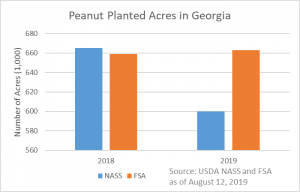Esendugue Greg Fonsah1 and Justin Shealey2
1Professor and REI Coordinator, Department of Agricultural & Applied Economics
University of Georgia, Tifton, GA 31793
And
2County Extension Coordinator, Echols County, University of Georgia
Click Here to download a PDF version of file
Despite the dynamism of the Georgia fruits, vegetable and tree nuts industry, this over $2 billion industry has embraced several difficult times in the past almost two decades. Let us start with the Montreal Protocol that recommended a complete eradication of Methyl Bromide because of its toxicity to the ozone layer. Then came the Salmonella Saint Paul that affected 43 states and 1,401 people infested nationwide. Then the Thrips and Tomato Spotted Wilt Virus (TSWV) showed up; then the Tomato Yellow Leave Curl Virus (TYLCV), then the 2017 frost that devastated over 50% of Georgia blueberries; then the 2018 Hurricane Michael devastated both specialty and row crops in South Georgia, including pecans. Still in 2018 and 2019, it was the tariff war between the U.S. and China and trade war between the U.S., Mexico and Canada, which ended up abolishing the North American Free Trade Agreement (NAFTA) that was created in 1994 and created the new United States, Mexico, Canada Agreement (USMCA) on September 30, 2018. Today, it is the Coronavirus also known as COVID-19. The difference between Covid-19 and the other reported incidences is that, while the others affected the specialty crop industry directly, the COVID-19 will indirectly affect the entire industry. Why? Because the COVID-19 is an airborne communicable disease and highly contagious virus that affects and causes death to human beings. Ever since COVID-19 became a pandemic, most countries including the United States have shut down their borders, Embassies and imposed travel restrictions.
Agriculture is the backbone of the state of Georgia and its economy with a farm gate value of about $14 billion. Most fruits (blueberries, strawberries, peaches, Muscadine grapes, satsuma citrus), and vegetables (pepper, squash, eggplant, cucumber, watermelon, sweet corn, greens, onions, carrots) etc., in Georgia are all handpicked, thus the need for seasonal, migrant and/or immigrant labor. These fruits and vegetables are currently getting mature in the fields in Georgia, the Southeast regions and other parts of the country. In other words, they are getting ready for harvesting and marketing. The announcement that the U.S. Embassy in Mexico will stop interviews of seasonal workers has sent another wave of panic to the existing COVID-19 pandemic fear. Common sense tells us that if this happens, chances are that there will be huge labor shortages, not only for Georgians, the Southeast region, but the entire country, especially if the decision is not reversed or relaxed in a timely manner.
In article 9112-FP from the Department of Homeland Security, U.S. Customs and Border Protection, 19CFR Chapter 1 entitled “Notification of Temporary Travel Restrictions Applicable to Land Ports of Entry and Ferries Service between the United States and Mexico” that went into effect at 11:59 p.m. (EDT) on March 20, 2020, clearly stated that this restriction will be observed until 11:59 p.m. EDT on April 20, 2020.
A shortage of migrant and/or immigrant seasonal workers caused by coronavirus will result into the following:
1. Huge field crop loss for some handpicked fruits and vegetables as some growers may not have enough seasonal or permanent labor force to harvest their crops.
2. Despite the anticipated seasonal and permanent worker shortages, the recommended social distancing for safety reasons will also delay the harvesting process and increase the loss incurred since these are mostly perishable food crops
3. If this happens, Georgia may lose over $billion if hypothetically, only 50% of its specialty crops are harvested. Nationwide, the entire fresh food industry may lose $billions in crop loss given the scenario describe above.
4. Although the U.S. exports significant amount of specialty crop to Mexico and Canada, the U.S. also imports more from these two countries than we sell to them. Thus, if the Covid-19 pandemic results in shutting down the boarders and restricting visas to migrant labor, that would deprive entry of the badly need fresh imported food from Mexico and Canada to subsidize the insufficient U.S. domestic production. That would further exacerbate the expected shortage caused by the lack of seasonal workers to handpick U.S. grown crops.
5. The huge shortage of both domestic and imported food would affect the entire fresh food value, supply chain, and result in a nationwide food crisis.
6. Furthermore, it would exponentially spike prices of the existing limited domestic quantity.
7. The lack of seasonal and/or permanent labor force needed for harvesting might put enormous financial pressure on our hardworking growers and might put some out of business without any form of government assistance1.
1Secretary Pompeo, in consultation with the Department of Homeland Security, has just relaxed the H-2A policy by waiving interviews to seasonal migrant workers whose visas expired 48 month ago including those who never had an H-2 visa. The relaxed policy is aimed at mitigating the foreseen problems vis-à-vis Covid-19, seasonal workers and national food supply shortages and, eventual price hike.
For more information, contact the Georgia Extension Vegetable Team:
Esendugue Greg Fonsah, Professor, REI Coordinator and Extension Agribusiness Economist, Fruits, Vegetables and Pecans, University of Georgia, Tifton, GA 31793; gfonsah@uga.edu Tel: 229-386-3512
Justin Shealey, County Extension Coordinator, Echols County, 109 Courthouse Street, Statenville, GA, 31648, University of Georgia, Email: justin1@uga.edu, Tel: 229-559-5562

